The category which I’ll call PFP (“profile pics,” in crypto Twitter speak), is expanding by the second and has come to encompass punks, apes, dogs, cats, frogs, misfits (don’t ask), and a whole sundry gamut of tongue-in-cheek derivatives inspired by CryptoPunks. To be clear, it’s not lost on me how idiotic merely typing the above makes me feel. The acronym PFP comes from the fact that many owners use these purchases as their social media avatars, which accounts for a chunk of their popularity and success. The famed CryptoPunks have traded approximately $400 million since their inception in June of 2017, MeeBits banked over $50 million for Punks creator’s Larva Labs since their May release (though it was widely reported as much more), and Bored Ape Yacht Club apes, up over 500 percent in the past week alone, have reached nearly $75 million. Meanwhile, new kids (or rather kitties) on the block Cool Cats NFTs, which were released in July and which have furnished Mike Tyson’s new avatar, are up to about $10 million already. Check out the rankings for yourself on OpenSea.
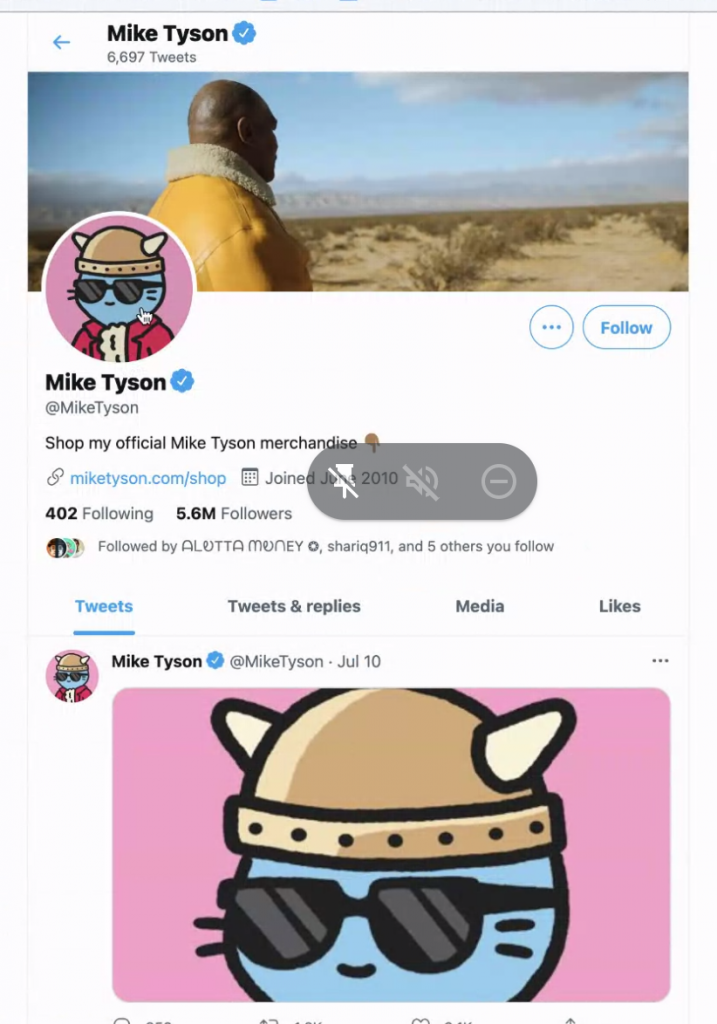
Iron Mike is one Cool Cat…or not? Courtesy of Kenny Schachter.
More unsettling than a bunch of juvenile, artless avatars are VeeFriends (10,250 tokens total, for now), named after Gary Vaynerchuk, the tech entrepreneur who styled himself a self-help guru and presently goes by the name GaryVee after a career as a wine critic who grew his family wine business (he changed the name to Empathy Wines, cue eye roll) and launched an online restaurant reservation company. The cliché critique “my child could have done it” does no justice to just how awful Veefriends look; yet, according to Mr. Vee, these little horrors emanated “straight from my soul.” Yes, we get what we deserve. Purchasing a VeeFriend is a ticket to a community of “friends”—providing a new measure of just how alienated we truly are—and comes with the added perk of a three-year admission to an annual “super-conference.” And, if you’ve accumulated enough, you can score some personal mentoring and coaching with Gary. Owning GaryVee tokens are like buying a few of Tony Robbins teeth and thereby gaining a seat in his mouth. I’d prefer Tony’s molars than a one-on-one meeting with GaryVee.
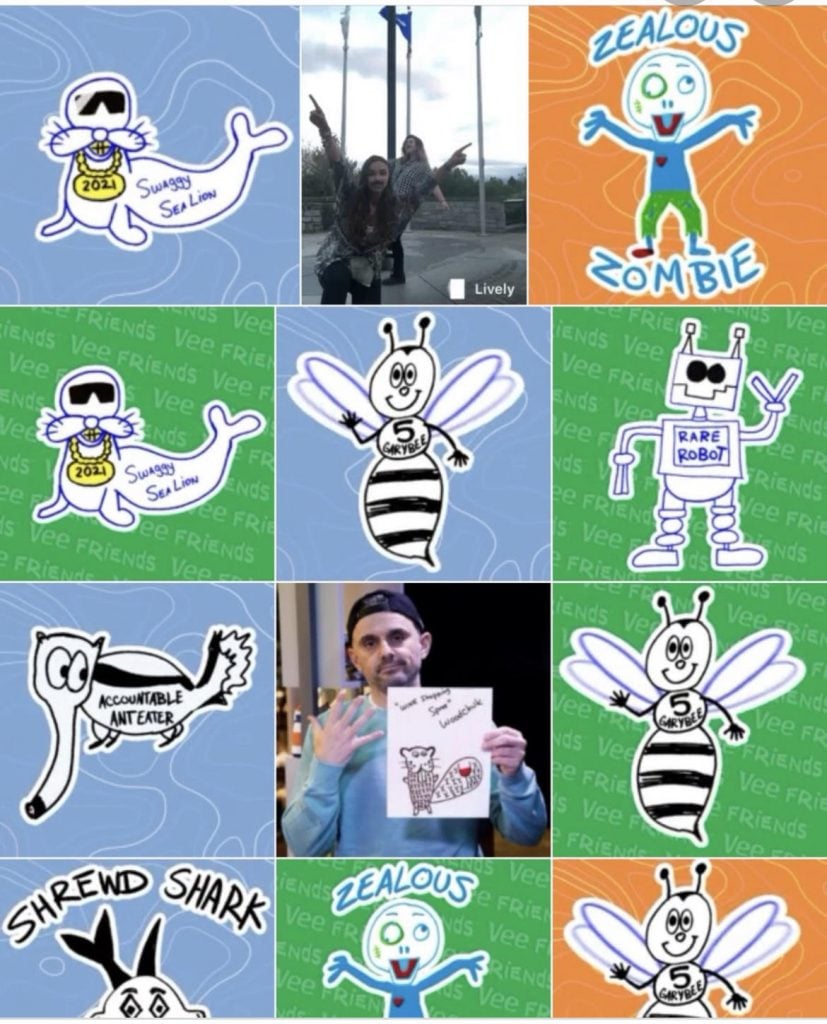
Gary Vaynerchuk poured his heart and soul into these characters. I think he’s more in a position of needing help than dishing it out. Courtesy of Kenny Schachter.
The default number for launching a PFP, it seems, is to offer 10,000 variants, though there are twenty thousand MeeBits and counting—Larva Labs has reserved the rights to increase the supply in fairly vague contractual terms. To make a universe of profile characters all you need are a set of variables, on average 10, that include distinctive facial features and accessories such as hats, earrings, shoes, and outfits. They are like vanity license plates combined with fashion to create alternative identities for our social media obsessed lives. Can someone shoot me, please?
A wrinkle in this rapidly changing NFT landscape are the appropriationists, like déjà vu all over again, art history style. The blockchain’s Wild West reputation didn’t come from thin air, though much else in this ethereal world did. Brazen NFT copyright infringement makes the antics of Richard Prince look like child’s play.
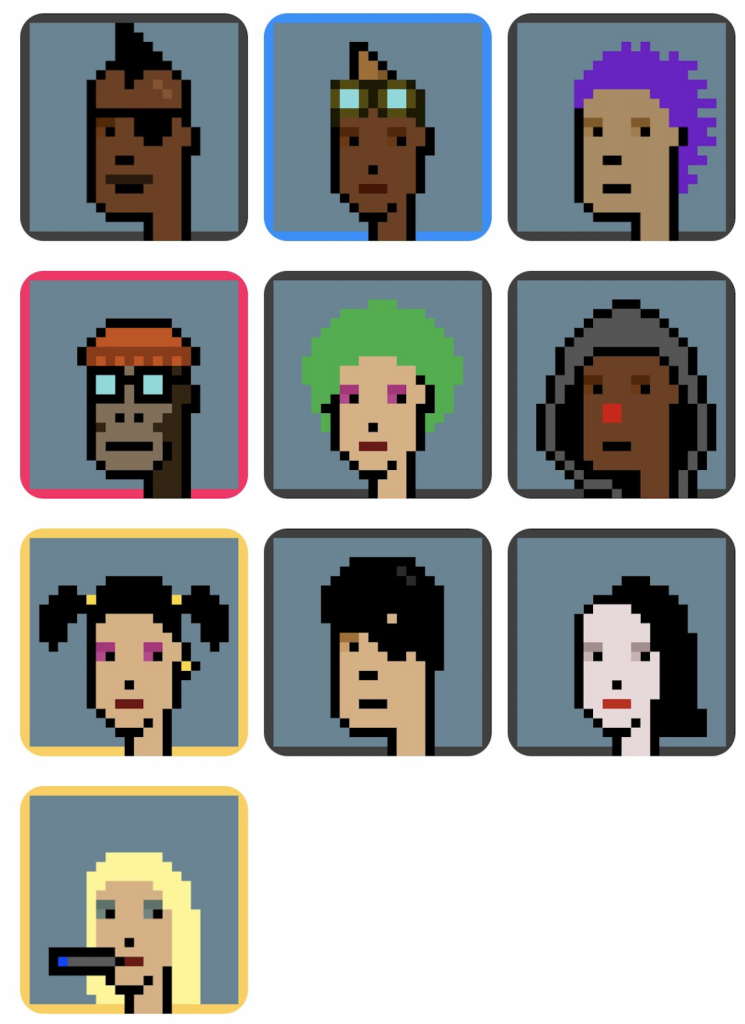
I can’t afford a Punk, granted, but I got myself a fistful of Phunks. The borders signify the degree of rarity, and maybe the scarcest, the monkey, may contribute to buying my house. Courtesy of Kenny Schachter.
Let’s start with the least problematic of the copycats—which is a good name for an NFT project, by the way, or alternatively Mutts, mashing all the above critters in a crypto cauldron and minting a fortune in the process. The recipe for CryptoPhunks was succinctly described on their eponymous website: “Our intern, Philip, hand flipped all 10,000 CryptoPunk images horizontally in Photoshop… Phunks face left, because the other way just doesn’t feel right.” Larva Labs was less than amused and issued repeated DMCA (Digital Millennium Copyright Act) letters to the various platforms that listed the Phunks, which swiftly sold out for $20 each and since resold at ever-increasing levels. No, I can’t afford a CryptoPunk between $50,000 and $10 million, but at $20 per I copped myself 10 Phunks. Alas, keeping up with where to find them as they get successively booted off websites like OpenSea and Rarible has become an ongoing endeavor. Oh, where, oh, where have my CryptoPhunks gone, oh, where, oh, where have they gone? At the moment they exist in a digital no-person’s land, punk pariahs.
The original CryptoPunks are getting knocked off faster than Rolexes, with SolPunks on the Solana Blockchain, and Binance Cryptopunks on that chain, neither of which have any features to distinguish them from the originals. I understand why Larva Labs is up in arms about protecting their simplistic little creations: when you buy a Jasper Johns canvas it doesn’t come with the right to manufacture 10,000 pairs of Jasper Johns boxer shorts. Besides, unwitting nitwits are easily confused. There are even Bored Ape Yacht Club knockoffs. Keeping up is exhausting and a full-time job. I am going to establish a tokenized NFTism legal system to adjudicate all these and the surfeit of future conflicts that inexorably will arise.
Changpeng Zhao, known as “CZ,” is the Chinese-Canadian founder of Binance, the world’s largest cryptocurrency exchange—at least, it was until being banned from operating in an increasingly long list of countries. The rogue stealth company has been on the run since its beginnings in China, hopping to Japan and Malta (and I’m certainly missing a country) before landing in the Cayman Islands in an effort to stay a step ahead of international regulatory bodies. Binance is currently under investigation in the United States for tax offenses and money laundering. By selling and/or hosting outright fake Punks on their new NFT platforms (there are two), not to mention “Warhols” (a far cry from Andy’s first official NFT, sanctioned by the Warhol Foundation and sold at Christie’s to the kids of David Khalili, the noted Arabic art collector), Binance is doing itself no favors by playing into the stereotype of Chinese companies flouting of intellectual property by cloning everything and anything under the sun. Besides, they only offer artists a 1 percent resale royalty (vs. the crypto industry norm of 10 percent).
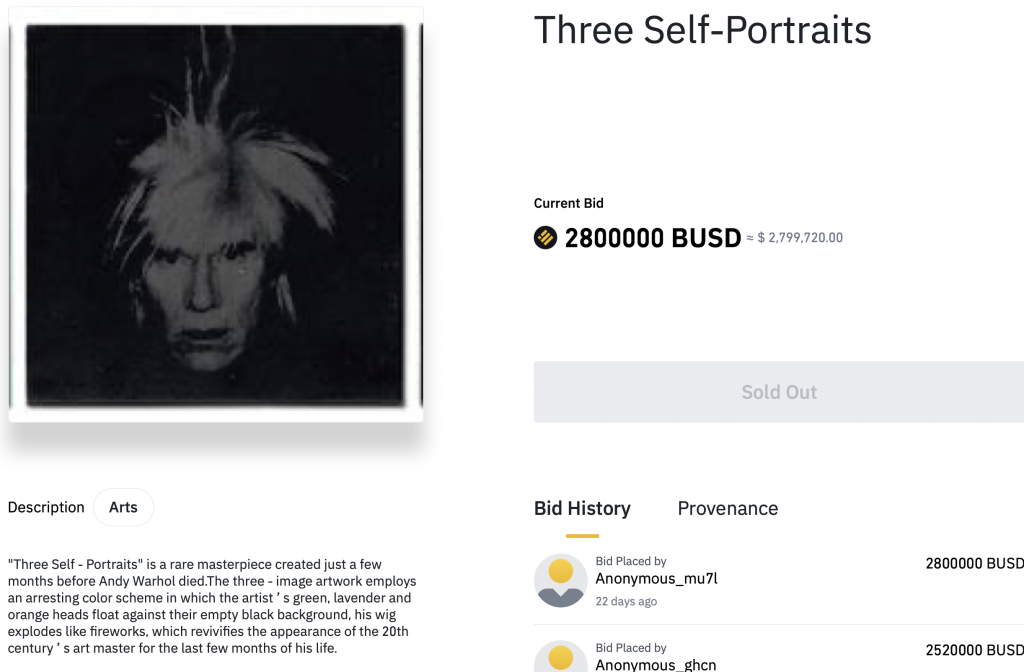
Nearly $3 million for three blatant Warhol ripoffs—it’s called a Binance bargain. Courtesy of Kenny Schachter.
Speaking of the sun, Binance is also affiliated with Justin Sun, the $69 million Beeple underbidder, also reportedly under scrutiny in China, whose (aptly named) Apeart is the instigator of the Warhol ripoff NFTs and his very own set of Punks called Tpunks. Together, Binance and Justin are crypto’s answer to Bonnie and Clyde. Neither makes the least effort to hide all this shameless commercial abuse, and instead flaunt their exploits. What would the original punks—the Ramones, New York Dolls, and Stooges (or the likes of Vito Acconci and Paul Thek)—make of all this? They’d probably puke tokens of disgust.
On the other side of the spectrum are Hashmasks, created by Suum Cuique Labs with a collective of over 70 global artists, which have traded more than $70 million worth to date. When you buy a Hashmask character (they are best described as Basquiatish), it’s accompanied by full copyright ownership so you are free to go nuts and make—and sell— your own Hashmask product range. (If you find that concept the least bit appealing.) In the meantime, Suum Cuique Labs are on the verge of a secret but imminent NFT drop in collaboration with a famous artist that will fly off the crypto shelves, mark my words.

I ate a pint of ice cream and went on a sugar-induced Hashmask buying spree. Yes, they are derivative looking, but I expect a jump when their imminent project is announced. Courtesy of Kenny Schachter.
There is little or no originality in art and the digital-sphere is no different. Damien’s new NFTs are the perfect anecdote for a society that, in the immortal words of Oscar Wilde, knows the price of everything and value of nothing. They are comprised of 10,000 (surprise, surprise, the magic number) NFTs that can be exchanged for paintings on paper of unique but practically identical dots—on top of the many thousands of dots his studio has already painted on canvas and released as prints. He’s unleashed a veritable rash of spots on the world. The most hands-on aspect of the project by far is Hirst’s signature: on the back of the works there is hologram of the artist’s head which is more artful than the art itself. They are more akin to the hybrid collectible bricks, hammers, fire extinguishers, and other oddities issued by the marketing genius Supreme. As has already been overstated, if you choose to keep the NFT the paper work is destroyed, and vice versa if you decide to keep the “art.”
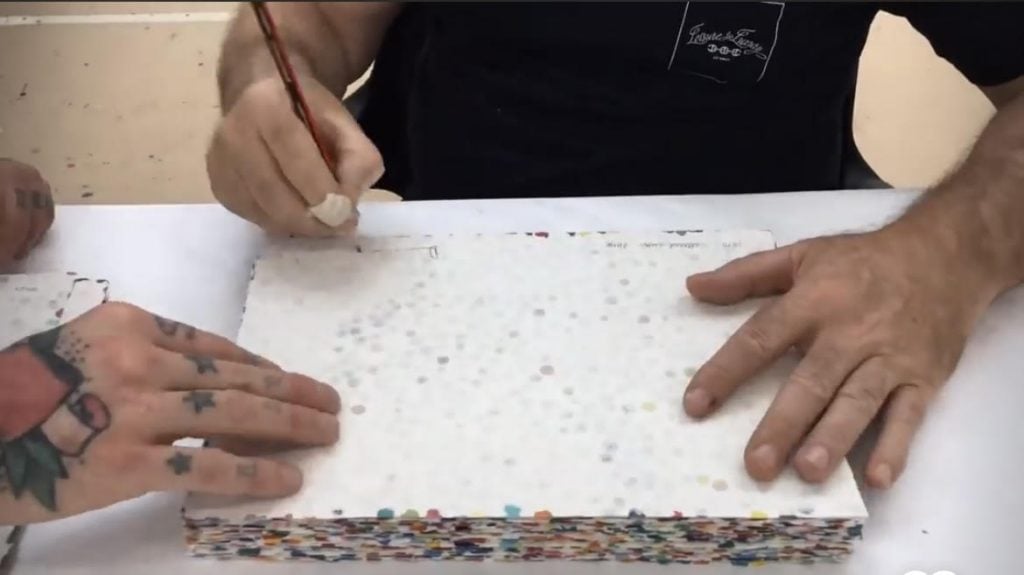
The art of the signature? On closer inspection the art IS the signature. The hologram is kind of cool, too. Courtesy of Kenny Schachter.
Granted, the first time Hirst laid eyes on his Currency works was probably when they first came out of the box for his John Hancock. But you can forgive Damien’s token of self-appreciation based on the fact that his early animal vitrines (mid-1980s) bear a thread of conceptual continuity with a Courbet still life—or he wouldn’t still be on everyone’s lips right now. Andy Warhol was said to collect “airplane menus, unpaid invoices, pizza dough, pornographic pulp novels, newspapers, stamps, supermarket flyers, [and] cookie jars” among other oddities and, truth be told, I am not terribly different. Like George Washington, I cannot tell a lie—I applied for five Hirst “tenders” (his nickname for the works). But let’s face it, this whole gimmicky phenomenon is turning the art world into more of a game than it was—and that was a lot already.
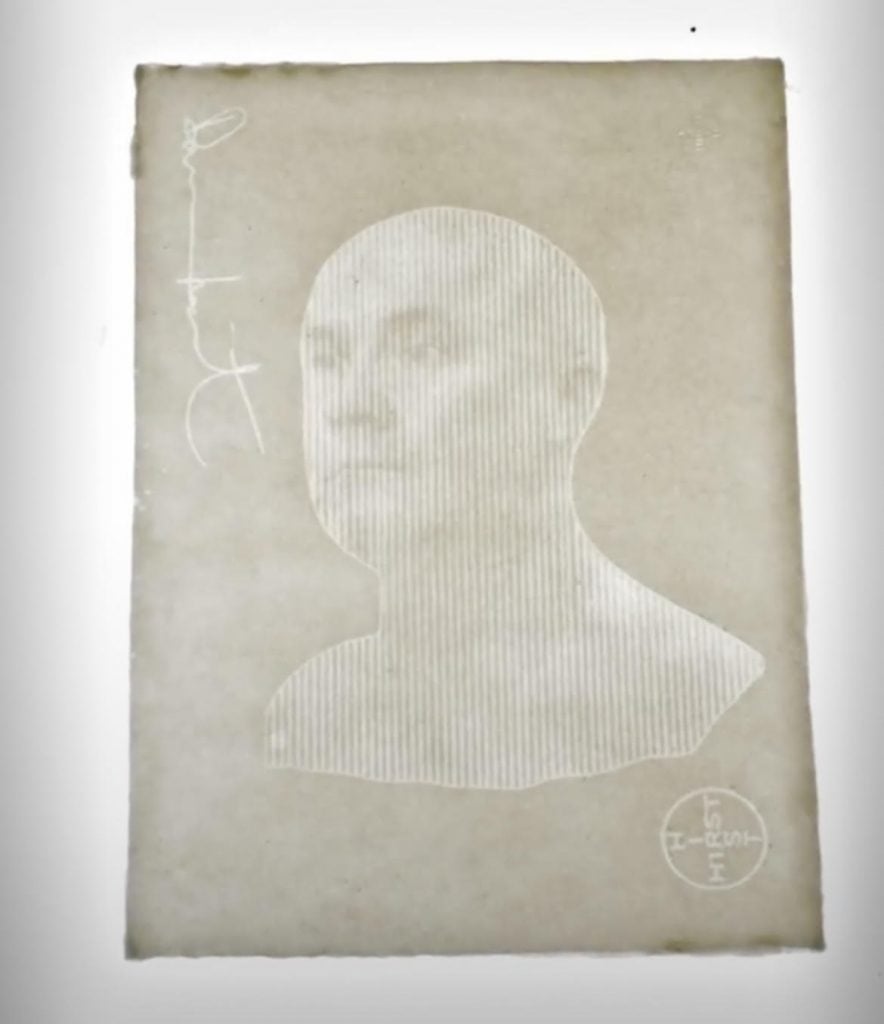
All branded up and no where to go… I can’t find any art in my Hirst NFT? Oh, wait, I found a hologram. Courtesy of Kenny Schachter.
I don’t know why the crypto world is so obsessed with burning things—perhaps it’s the advent of the shrooms-and-acid-fueled cheese-fest known as Burning Man, which it so happens is where many crypto-folk had their first art epiphany, rather than MoMA or the Tate. In the beginning, way back in 2018, there was a tendency to mint mega-sized digital impressions of each NFT. Mad Dog Jones gives you the right to trade in older NFTs, which he sends to a burner address, the blockchain equivalent of the La Brea Tar Pits, and compensates you with smaller editioned works. Also, artist PAK created his own cryptocurrency called ASH where you are rewarded for sending in your “Cube” works by the artist, which in turn get wiped out.
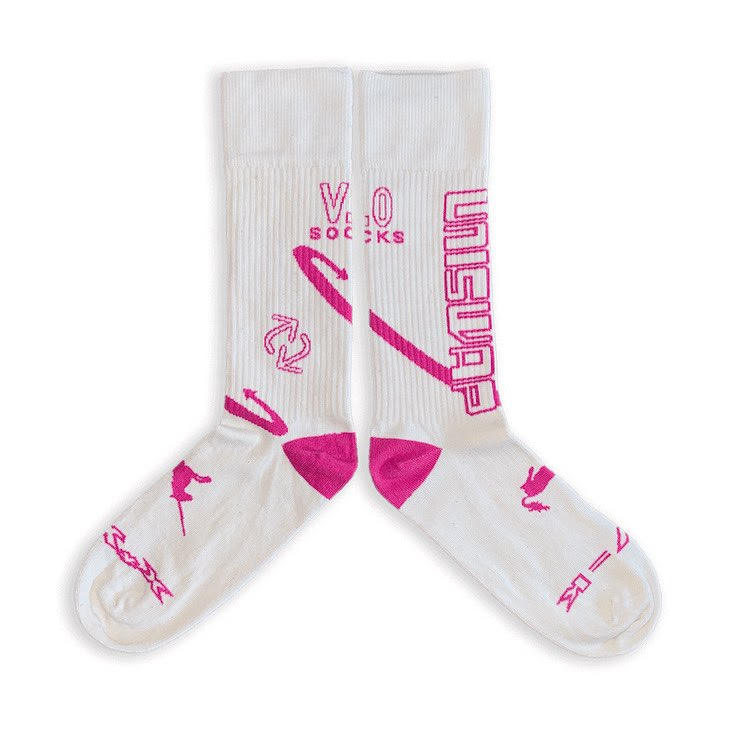
The $150,000 pair of socks, giving new significance to losing one in the laundry! Courtesy of Kenny Schachter.
Best of all was Uniswap’s—the online exchange run solely on code with under a dozen employees trading billions of dollars on a daily basis (the future of business in my estimation)—promotional Unisock. You could either keep the tokens, now worth over $40,000 each from a high of nearly $160,000, or be a badass and get yourself the most expensive pair of socks by a long shot, the world has ever known. But you’ll need an art conservator to darn them.
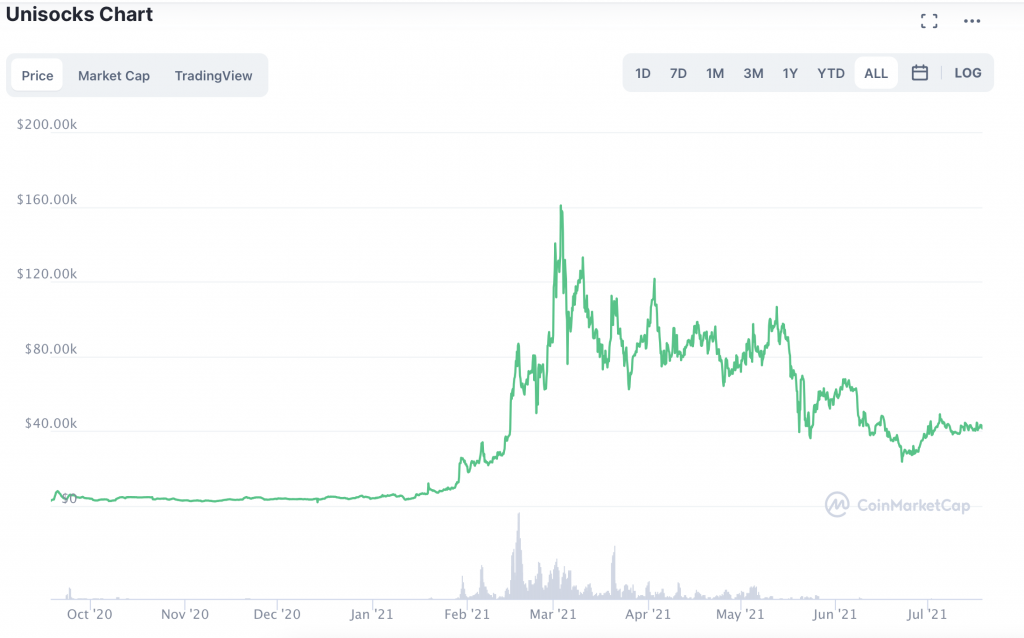
Darn those socks! They were once worth nearly $160,000! The world’s most expensive pair by a long shot, should you dare to exchange your token now worth more than $40,000. Courtesy of Kenny Schachter.
I was recently contacted by Jay-Z’s people—ok, his art advisor—to lend him my “team of animators” for an overnight session to assist on his recent foray into NFTs with artist Derek Adams that Sotheby’s sold for $138,600. I suppose this was an effort to quash Damon Dash, his former partner in Roc-A-Fella records, from releasing a version of his own on the same subject. My “team,” incidentally, is me and the husband-and-wife duo of MOSTRA, and they were too busy with me. By the way, circling back to PFPs, Jay-Z replaced his Twitter avatar with a CryptoPunk that he purchased in April for about $115,000 after making a woefully unsuccessful offer of $300 on another.
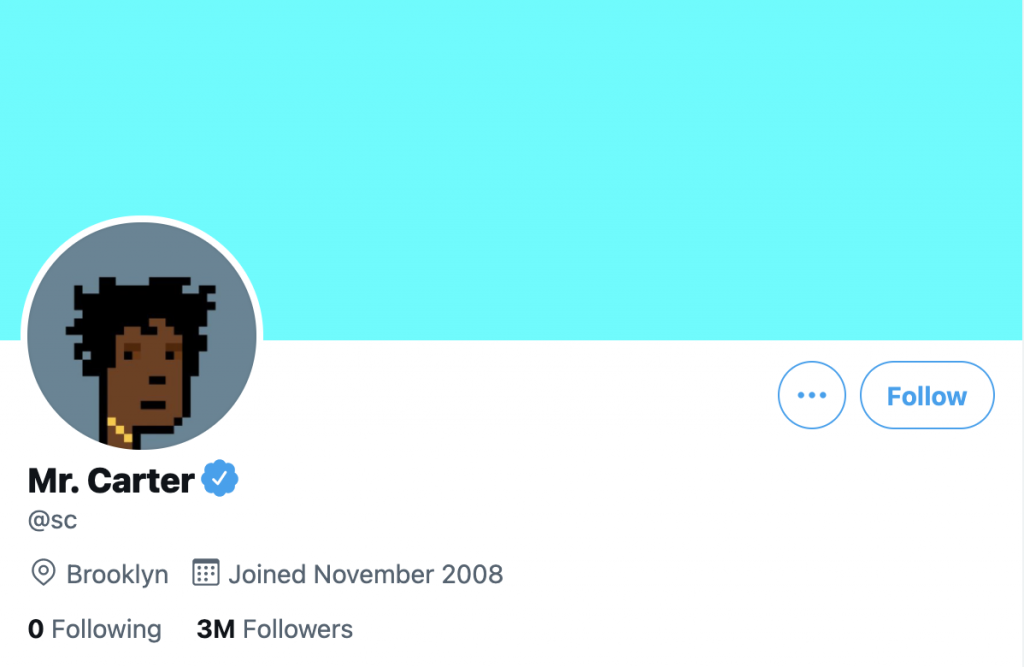
His first bid of $300 didn’t cut it, but he got there in the end: Jay-Z’s $115,000 Punk. With the size of his crypto war chest there is a lot more action to come! Courtesy of Kenny Schachter.
Following the breadcrumbs (the indelible trail on the blockchain like the secretion of a snail), a series of runner accounts traceable to Jay’s wallet indicate the music mogul deposited tens of millions of dollars worth of ETH into his account. I’d say that qualifies as a long view on crypto, and sizable war chest. I’ve taken the liberty of updating the lyrics of Jay’s song “D’evils”: “We used to fight for building blocks/Now we fight for blocks with buildings that make a killin’/Traded in our gold chains for NFTs on the blockchain.”
Now for something even stupider than all the above combined. Rulton Fyder (a play on Richard Prince’s publishing imprint Fulton Ryder), aka Artorious, aka Pest Supply (a play on Banksy’s authentication arm), the anonymous art dealer/NFTist, made a fast million and caused a stir earlier this year when he successfully hijacked the visual language of classic Banksy graphics to create his first series of NFTs. Rulton contacted me soon after, mentioning his penchant for Russian prostitutes and cocaine for some odd reason and saying I had done a favor for him in a restaurant a couple of years ago—and, as a result, he wanted to reward me. He asked for my wallet address and proceeded to deposit dozens of his digital appropriations over the ensuing months. Then, into the picture came artist Ryder Ripps (his real name, you can’t make this shit up). Although Ryder sold his audio sex tape NFT feat. Azealia Banks to Rulton (are you following me?), Ryder became suspicious of various online activities of Rulton. Speaking of sex, they both sound like porn-star names in this still unfolding crypto soap-opera saga.
Ok, here’s the gist of the Rulton-Ryder rhubarb. Ryder traced multiple accounts that were bidding up Rulton’s NFTs and tokens, which were all traceable back to Rulton. There were a bunch of journals that Rulton is also anonymously behind talking up his own works and the crypto coins, Erotica for one, that Rulton created, to sell (more) sex NFTs, though to date it’s just been traded as a shell with no content. There was even an account in the name of Simon de Pury on NFT site Rarible traceable to Rulton, which Simon was none too pleased about when I informed him.
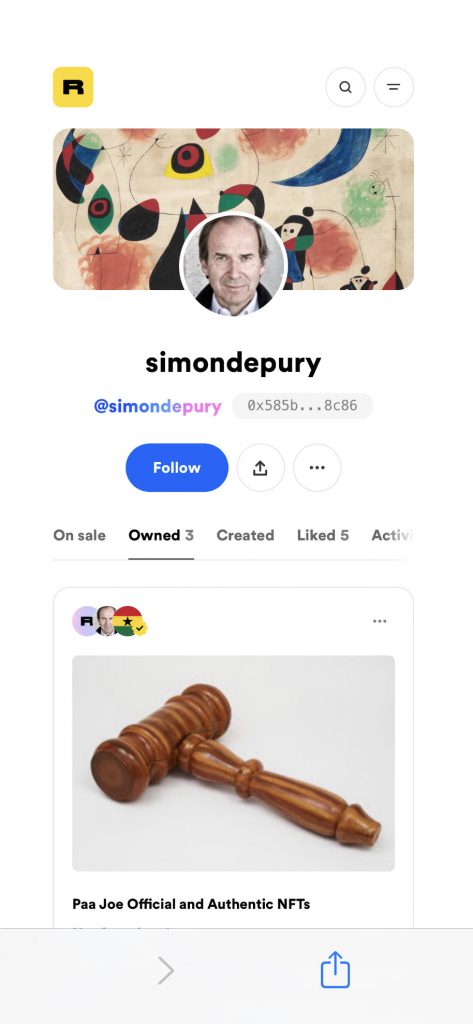 Ryder has been on nothing short of a crusade to unearth the true identity of the person behind the pump-and-dump scheme, in which he churns fake accounts to create the impression of demand for his crypto forays. (See Ryder’s research here). Such behavior might be common in some precincts of the art world, but they are a hell of a lot easier to effectuate on the blockchain. At one point I was going to write an essay for Rulton’s exhibit in German gallery Pulpo, but the ridiculousness of this all was too much. Even for me. Either way, they’re both selling internet sex without climaxes.
Ryder has been on nothing short of a crusade to unearth the true identity of the person behind the pump-and-dump scheme, in which he churns fake accounts to create the impression of demand for his crypto forays. (See Ryder’s research here). Such behavior might be common in some precincts of the art world, but they are a hell of a lot easier to effectuate on the blockchain. At one point I was going to write an essay for Rulton’s exhibit in German gallery Pulpo, but the ridiculousness of this all was too much. Even for me. Either way, they’re both selling internet sex without climaxes.
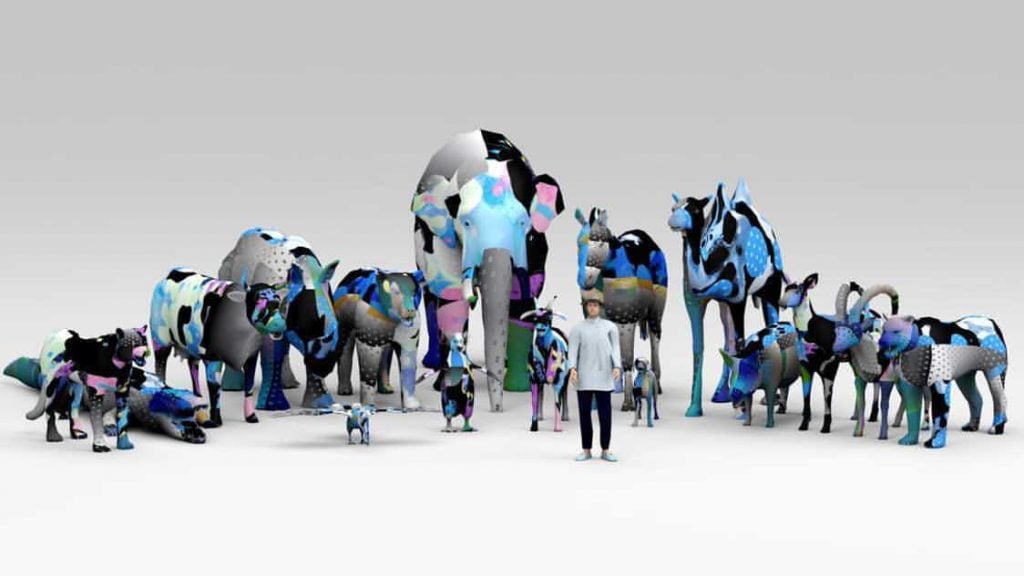
Jonas Lund’s metaverse version of Noah’s Ark, which by its reduced digital footprint will leave plenty of spare room for others to join the trip. Courtesy of Kenny Schachter.
On a (much) more positive note, there is the artist Jonas Lund and his JLT (Jonas Lund Token). Though he is not the first to tokenize himself—Rhea Myers, who is in my show Breadcrumbs at Nagel + Draxler Gallery in Cologne through August 21, did it with his soul in 2014—I’m pretty sure Lund is the first to create a DAO (Decentralized Autonomous Organization, and if you don’t know what it is, you will soon, trust me) for coinholders to contribute to the administering of all aspects of his art life, including suggesting proposals for his career and works. If you own JLT, you also share in the profits from his practice, including his latest show at Johann König’s Dencentraland metaverse gallery.
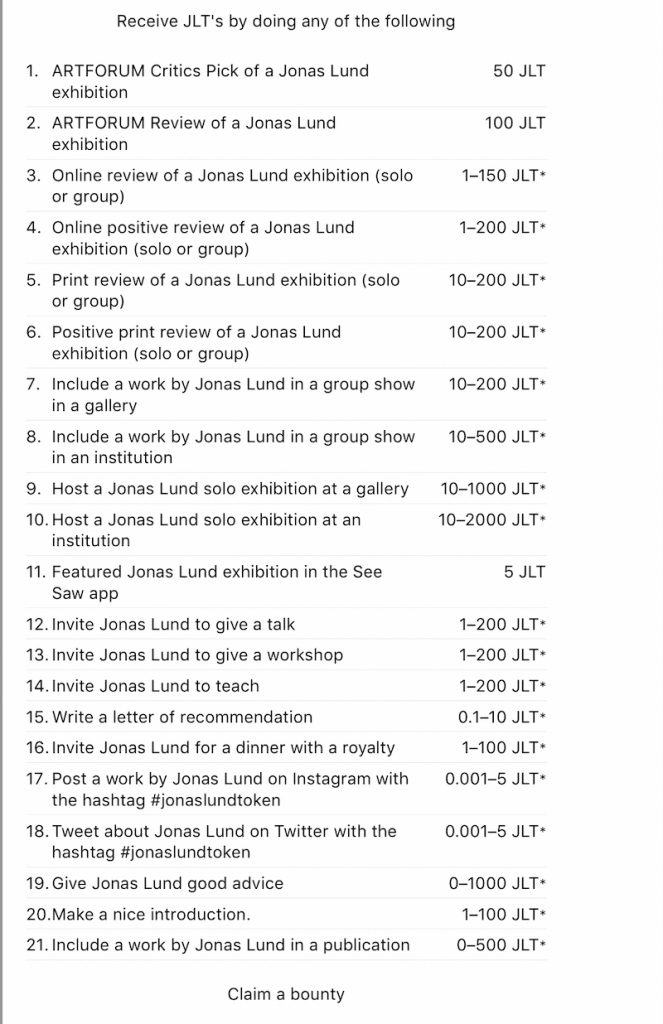
Jonas Lund is a mercenary who puts bounties on his own head. Love it. Courtesy of Kenny Schachter.
The Lund stakeholders helped choose the figurative content of his Memory pieces in the exhibit, steering the artist away from abstractions. It’s like creating a cult and assuming the role of both leader and follower—simultaneously. Sounds good to me; I’m a fan. There is also a bounty list to encourage those with a vested interest to further the cause by rewarding them with more tokens if they contribute to advancing his notoriety with posts and articles, et cetera. He already reserved a seat for me at the table if this mention should qualify. In all honesty and in the name of transparency, I hope so!
Today, there is a new NFT platform, innovation, and auction every second. And it won’t stop anytime soon. You can rent out your NFTs, buy and sell at an NFT online auction house, or participate in curator led initiatives like https://jpg.space or www.institut.co, where I am organizing the first show (with an accompanying physical exhibit at Unit Gallery) in London opening September 10 and featuring 100 artists. There is even a crypto-driven site for writers—ahem, take note, Artnet. (And, by the way, when are you going to accept crypto for a Pro membership already, Artnet?). Granted, 90 percent of NFTs may very well be worthless in three to five years, as Coinbase exchange founder Fred Ehrsam warned in a recent Bloomberg interview—but, then again, so will most of the art on offer at the next iteration of Frieze.
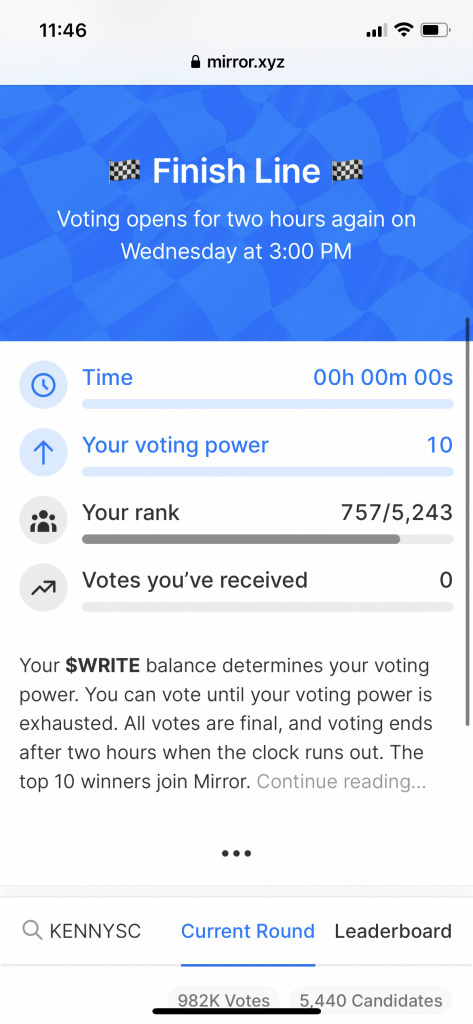
Looks like I stumbled and didn’t quite make it to the end, so Artnet is stuck with me for the foreseeable future. Courtesy of Kenny Schachter.


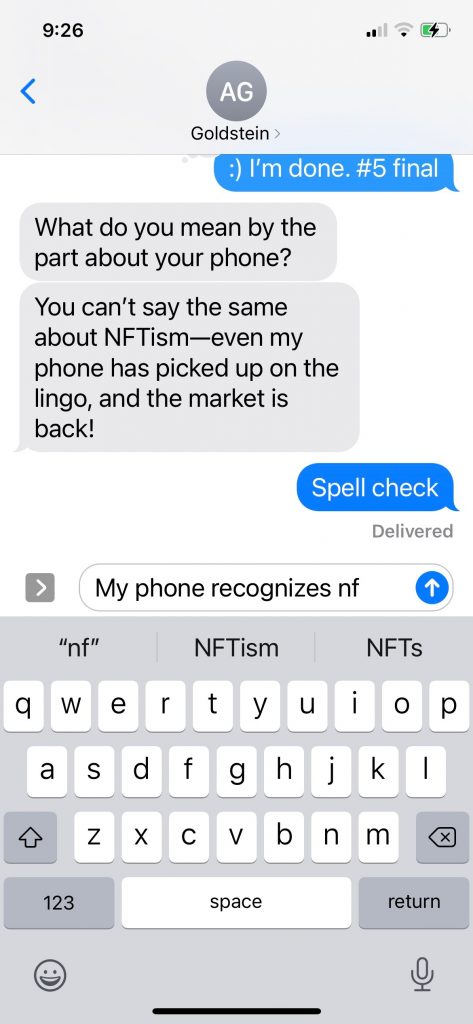
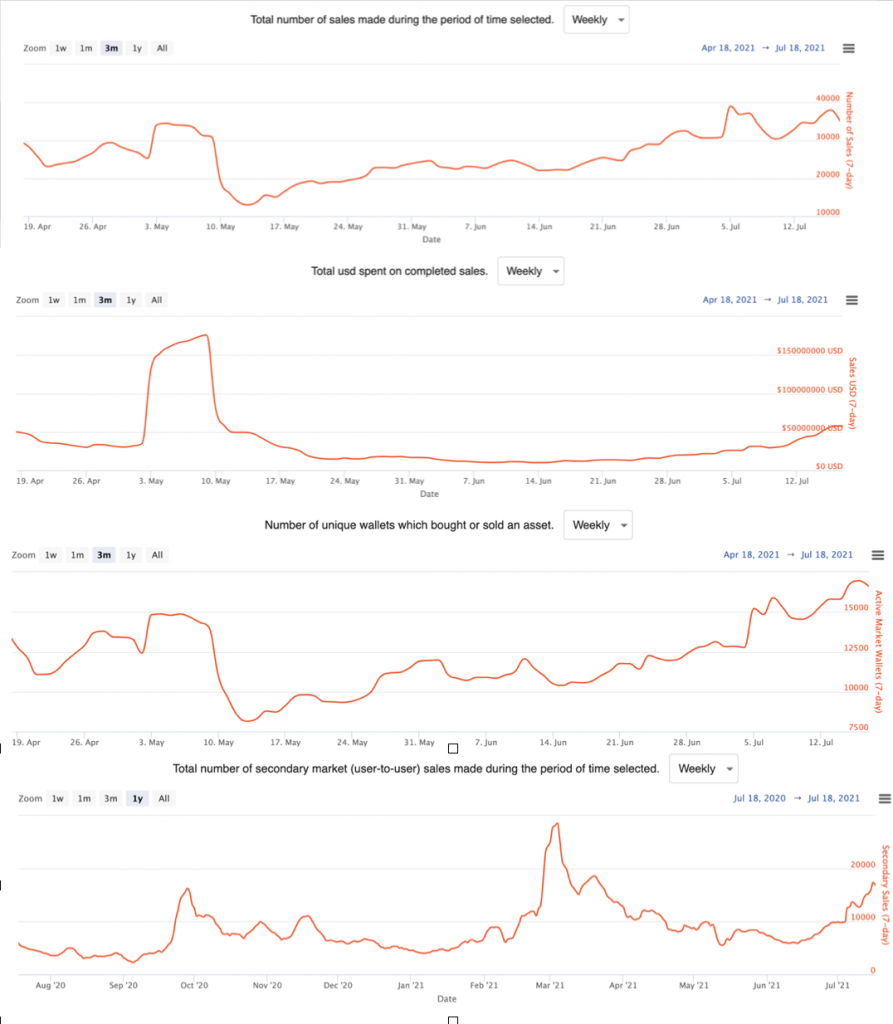










 Ryder has been on nothing short of a crusade to unearth the true identity of the person behind the pump-and-dump scheme, in which he churns fake accounts to create the impression of demand for his crypto forays. (See Ryder’s research
Ryder has been on nothing short of a crusade to unearth the true identity of the person behind the pump-and-dump scheme, in which he churns fake accounts to create the impression of demand for his crypto forays. (See Ryder’s research 







